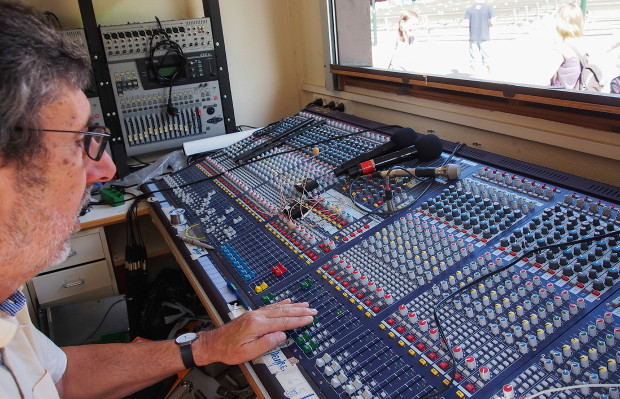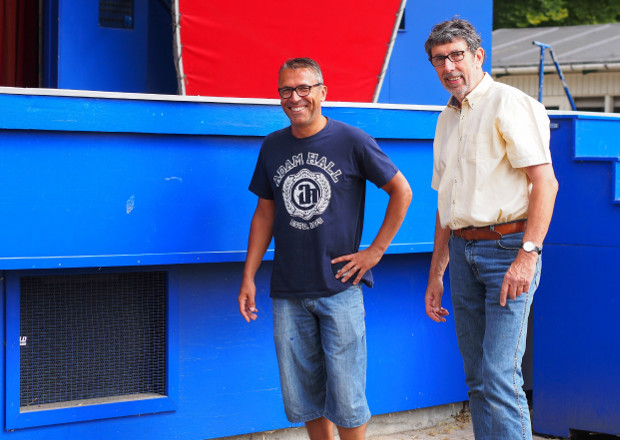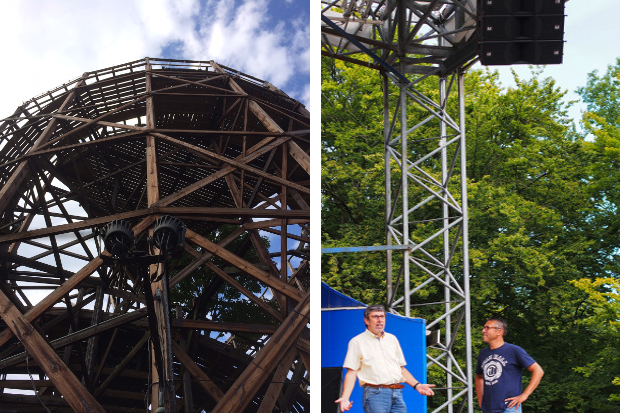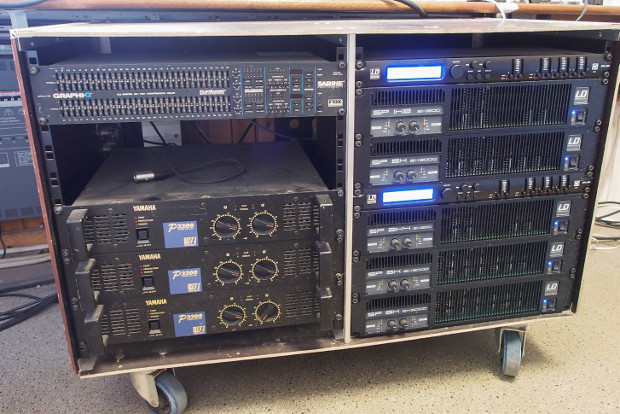LD Systems & Cameo Light at the Bakken amusement park in Copenhagen
The open-air stage at the amusement park of Bakken in Copenhagen had been working with the same electro-voice-point-source PA system for many years. It was high time to replace it with a more contemporary system. The challenge was to set up a system allowing for better control of the spread of sound, and at the same time causing as little disturbance as possible to other areas of Bakken and adjacent neighbours. The first choice was for a line array system from the German brand LD System, part of the Adam Hall Group, the first of its kind in Denmark. Monitor Pro has been on site to hear how this problem was solved.

It is well known that each place, kiosk, and attraction is self-contained at the Bakken amusement park in Copenhagen. The open-air stage is a shared installation and therefore it is often difficult to bring decisions and finances regarding this stage to a common denominator. Adam Hall has a representative of LD Systems in Denmark and installed a demo system on site three years ago, to prove its efficiency. It wasn’t long before everyone at Bakken agreed on this PA system because of its sound quality, sound propagation and its value for money for the open-air stage. And yet it was not installed until this spring due to some delays. One reason it took three years, was due to considerations for potentially rebuilding the stage itself. That did not happen, however.

Allen Collins is technical manager for the open-air stage and is responsible for most concerts and events on this stage. Before choosing LD Systems, Allen Collins had listened to many other, more expensive systems that had been rented over time for the stage. He explains that, among others, PA systems from d&b, Meyer Sound, Ohm, EV & Martin had been installed at the open-air stage.
A new system is installed
The new PA system consists of two line array columns each with eight LD-VA8 loudspeakers. Under the stage are four LD-V218B subwoofers, each with 2 x 18″ bass speakers. All speakers are passive. Therefore, a stack of amplifiers and a speaker management unit are located behind the stage, to provide power to the system. Allen Collins has chosen to divide the system, so that the lower five speakers of each column form one system, and the upper a second system. So at times, he can use just the smaller system, if necessary. The top three speakers provide the loudest sound for the venue and therefore, are the ones which can potentially cause the most problems for the “other” side of Bakken, and to local residents.

Allen Collins says: “The open-air stage is at a right angle to the middle of one of the main roads within Bakken. With the new PA system, you notice that the sound is much weaker when you get out of the coverage area. There is no comparison with the old EV-point-source system; this new one is much, much better. The first concert, at which the system was used, was a children’s concert at moderate sound pressure. At the restaurant, which was in close proximity to the open-air stage, it was almost impossible to hear any of it. So, this is perfect. This is also the reason why I divided the system into two parts. So I have completely independent control of the top three speakers on each column, intended for long distance coverage at Bakken. I can control both parts of the system from the control panel below and do not have to go behind the stage.” Allen Collins has taken on the installation and calibration of the system using the measurements carried out three years ago with the demo system. At that time, system engineers from LD Systems determined the measurements and made suggestions for the installation. After using the system for this season, Allen Collins is very satisfied, even if he will change the angular orientation of the speaker slightly after the season, so that the bottom speakers emit a little more towards the heads of the visitors.
The line array speaker LD-VA8 is quite compact, but is still the largest of its kind at LD Systems. The cabinet contains two 8 inch speakers and a dual 1 inch compression driver. This plays on a common horn and waveguide. The speaker is about 75 x 25 x 50 cm tall and weighs almost 30 kilos. Each speaker is rated for 500 W RMS / 1000 W peak, the dispersion is 100 degrees horizontally and 10 degrees vertically. Using fittings and adjusters, each speaker in the line array can be gradually aligned by 0-6 degrees.
The subwoofer V218B in the system has two 18 inch units, which are installed in a solid bass-reflex enclosure. The speakers can range from 38 up to 200 Hz; they are designed for 1600 W RMS and weigh 86 kilograms. When installing on the open-air stage at Bakken, the four subwoofers were not stacked, but put under the stage along the edge and set up so as to act almost like a remote sound system.
“The active line array loudspeaker system from LD Systems meets the requirements of Bakken’s open-air stage completely” Allen Collins, technical manager for the open air stage at Bakken.

Sound quality
This line array system is one of the cheapest on the market, but we have tried to evaluate the sound quality, irrespective of the price differentials. Unfortunately, there was no concert at Bakken on the day Monitor Pro came for a visit. Therefore, we had to settle for listening to pre-recorded music on the system. The sound is controlled from a small shed, using a Midas Verona console. Allen Collins hopes, however, that he can replace it with a new Midas M32 digital console, as soon as it comes on the market. From the shed, the sound is quite different from outside in the square, but Allen Collins understands the conditions well and knows what needs to be compensated for when mixing the sounds. Larger bands set up their own digital console outside, where the sound conditions are slightly better. Of course, we listened to the system outside on the square, that accommodates around 300 seats and a good 2000 standing places for the audience.
The system was able to play really loudly, and yet there was a lot more power in reserve. Out of consideration for the neighbours, we tested only the close range of the system, i.e. the lower four speakers of each column. The harmony between the subwoofer and the rest of the system was good, even for music with plenty of bass. The sound in the audience area was relatively homogeneous, and when moving towards the direction of the booths, the sound pressure fell pretty quickly – exactly as was desired. The first row of seats was not yet perfect, the sound was projected slightly over the heads of the audience. But that will be corrected when Allan Collins changes the angle of the two lower speakers after the season. Even when sliding just one metre backwards into the second row, the sound was already a lot better.
The system had no master EQ at the console, but only the EQs located in the speaker-management units on stage. Here, Allen Collins made a few tweaks, but the high mids seemed rather too dominant, especially when sitting directly at a right angle to the direction of the sound, facing the horns of the line array column; a common problem in many line array systems.
The system is situated relatively far away on the open-air stage, therefore, there is quite a strong sound effect when playing on stage. In contrast, the sound on stage was not as bass-heavy. We asked Allen Collins whether he had therefore experienced any feedback or similar issues, but he said no.
The points of difference with the pricier PA systems, are among other things, the precision in the transient and also the fast, precise stop when a sound stops. That is how you achieve a good sound definition, which means that even when playing complex music, each instrument, note and musical nuance can be heard and distinguished. This system has not failed on these points in any way, but nevertheless, there is a little criticism. At 300 to 600 Hz, there were nuances where the sound was not very well defined in this system.

Financially Speaking
Of course, it is clear that you cannot expect equivalent performance from a system that costs 10-20 percent less than the more expensive systems. At the same time, we also know that it is hard to compare, because many parameters and conditions play a role. Therefore, let’s put aside the comparison and agree that a line-array from LD Systems can easily meet the requirements of a stage such as the open-air stage at Bakken. Allen Collins reported that the budget for this PA system was very restricted. The system with amplifier, speaker management, speakers, cables, suspensions and everything else that goes with it, was just under DKK 200,000. The sound quality has tremendously improved as compared with the old system and significantly reduces the problems with sound propagation as well as the disturbance to the neighbourhood. In addition, this budget framework still offered room to expand and improve the lighting system on the stage with LED projectors from Cameo Light. And apart from one sound technician, who wanted deeper sound capacities, the response of all technicians who have mixed on the new PA system in the course of the summer was wholly positive.
You will find further information on LD Systems at:
http://www.ld-systems.com/en/home/
Source: www.monitor.dk, Denmark, September 2014
Leave a Comment
You must be logged in to post a comment.












